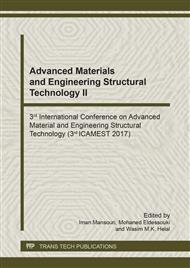[1]
Y.W. Mao, Metallurgical melt, Beijing: Metallurgical industry press, (1994).
Google Scholar
[2]
G. Chen, H.Z. Fu, et al, Non-equilibrium solidification of new metal materials, Beijing: Science press. (2004).
Google Scholar
[3]
Z.H. Huang. Formation and crystallization behaviors of Al-TM-RE based amorphous alloys. Shanghai jiaotong University, Shanghai, China, (2008).
Google Scholar
[4]
K. Hono, Y. Zhang, A.P. Tsai, et al. Solute partitioning in partially crystallized Al-Ni-Ce (-Cu) metallic glasses. Scripta metallurgica Et Materialia, 1995, 32(2): 191-196.
DOI: 10.1016/s0956-716x(99)80035-1
Google Scholar
[5]
J. W Wang, C.S. Ma, J. Zhang, et al. Progress in research on glass forming ability of Al-based metallic, Chinese journal of materials research, 2008, 22: 113-119.
Google Scholar
[6]
W.S. Sanders, J.S. Warner, D.B. Miracle. Stability of Al rich glasses in the Al-La-Ni system. Intermetallics, 2006, 14: 348-351.
DOI: 10.1016/j.intermet.2005.06.009
Google Scholar
[7]
J. Mao, H.F. Zhang, H.M. Fu, et al. The effects of casting temperature on the glass formation of Zr-based metallic glasses. Advanced Engineering Materials, 2010, 11 (12) : 986-991.
Google Scholar
[8]
J. Mao, H.F. Zhang, H.M. Fu, et al. Effects of casting temperature on mechanical properties of Zr-based metallic glasses. Materials Science and Engineering A, 2010, 527: 981-985.
DOI: 10.1016/j.msea.2009.09.040
Google Scholar
[9]
Z.W. Zhu, H.F. Zhang, H. Wang, et al, Influence of casting temperature on microstructures and mechanical properties of Cu50Zr45. 5Ti2. 5Y2 metallic glass prepared using copper mold casting. Journal of materials research, 2009, 24: 3108-3115.
DOI: 10.1557/jmr.2009.0373
Google Scholar
[10]
Z.W. Zhu, S.J. Zheng, H.F. Zhang, et al. Plasticity of bulk metallic glasses improved by controlling the solidification condition. Journal of materials research, 2008, 23: 941-948.
DOI: 10.1557/jmr.2008.0127
Google Scholar
[11]
V. Manov, A. Rubshtein, A. Voronel, et al. Vereshagin. Effect of melt temperature on the electrical resistivity and crystallization temperature of Al91La5Ni4 and Al91Ce5Ni4 amorphous alloys. Materials science and engineering A, 1994, s179-180: 91-96.
DOI: 10.1016/0921-5093(94)90171-6
Google Scholar
[12]
J. Wu, H.M. Fu, Z.W. Zhu, et al. The effect of melt treatment on glass forming ability and thermal stability of Al-based amorphous. Advanced Engineering Materials, 2010, 12, 1127-1130.
DOI: 10.1002/adem.201000163
Google Scholar


